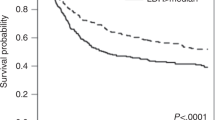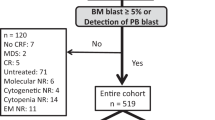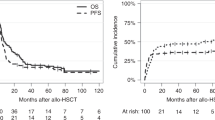Abstract
Prognostic factors for survival following allogeneic BMT for AML include age, disease status and cytogenetic risk classification. Lactate dehydrogenase (LDH) levels have not been studied as a potential risk factor. We reviewed our experience with BMT for AML and included LDH at the time of admission in an analysis of prognostic factors for survival. We found that LDH >330 U/l (1.5 times the upper limit of normal at our institution), older age, active disease, peripheral stem cell graft and male-to-male transplant were significant adverse predictors of survival. After accounting for LDH, other factors such as disease status and cytogenetics were not significantly associated with the outcome of BMT. All but one patient with an LDH >330 U/l had active disease. However, when patients in CR were excluded, LDH >330 U/l remained a significant adverse predictor of overall survival (hazard ratio 2.70, 95% confidence interval 1.41–5.16, P=0.003). We conclude that LDH is an important adverse risk factor for survival and should be included in future studies of risk performed on larger patient cohorts.
This is a preview of subscription content, access via your institution
Access options
Subscribe to this journal
Receive 12 print issues and online access
$259.00 per year
only $21.58 per issue
Buy this article
- Purchase on Springer Link
- Instant access to full article PDF
Prices may be subject to local taxes which are calculated during checkout

Similar content being viewed by others
References
Yanada M, Matsuo K, Emi N, Naoe T . Efficacy of allogeneic hematopoietic stem cell transplantation depends on cytogenetic risk for acute myeloid leukemia in first disease remission. Cancer 2005; 103: 1652–1658.
Ferrant A, Labopin M, Frassoni F, Prentice HG, Cahn JY, Blaise D et al. Karyotype in acute myeloblastic leukemia: prognostic significance for bone marrow transplantation in first remission: a European Group for Blood and Marrow Transplantation Study. Blood 1997; 90: 2931–2938.
Gale RP, Horowitz MM, Weiner RS, Ash RC, Atkinson K, Babu R et al. Impact of cytogenetic abnormalities on outcome of bone marrow transplants in acute myelogenous leukemia in first remission. Bone Marrow Transplant 1995; 16: 203–208.
Keating S, Suciu S, de Witte T, Mandelli F, Willemze R, Resegotti L et al. Prognostic factors of patients with acute myeloid leukemia (AML) allografted in first complete remission: an analysis of the EORTC-GIMEMA AML 8A trial. The European Organization for Research and Treatment of Cancer (EORTC) and the Gruppo Italiano Malattie Ematologiche Maligne dell’ Adulto (GIMEMA) Leukemia Cooperative Groups. Bone Marrow Transplant 1996; 17: 993–1001.
Grigg AP, Szer J, Beresford J, Dodds A, Bradstock K, Durrant S et al. Factors affecting the outcome of allogeneic bone marrow transplantation for adult patients with refractory or relapsed acute leukaemia. Br J Haematol 1999; 107: 409–418.
Frassoni F, Labopin M, Powles R, Mary JY, Arcese W, Bacigalupo A et al. Effect of centre on outcome of bone-marrow transplantation for acute myeloid leukaemia. Acute Leukaemia Working Party of the European Group for Blood and Marrow Transplantation. Lancet 2000; 355: 1393–1398.
Michallet M, Thomas X, Vernant JP, Kuentz M, Socie G, Espérou-Bourdeau H et al. Long-term outcome after allogeneic hematopoietic stem cell transplantation for advanced stage acute myeloblastic leukemia: a retrospective study of 379 patients reported to the Société Française de Greffe de Moelle (SFGM). Bone Marrow Transplant 2000; 26: 1157–1163.
Biggs JC, Horowitz MM, Gale RP, Ash RC, Atkinson K, Helbig W et al. Bone marrow transplants may cure patients with acute leukemia never achieving remission with chemotherapy. Blood 1992; 80: 1090–1093.
Blum W, Bolwell BJ, Phillips G, Farag SS, Lin TS, Avalos BR et al. High disease burden is associated with poor outcomes for patients with acute myeloid leukemia not in remission who undergo unrelated donor cell transplantation. Biol Blood Marrow Transplant 2006; 12: 61–67.
Sierra J, Storer B, Hansen JA, Bjerke JW, Martin PJ, Petersdorf EW et al. Transplantation of marrow cells from unrelated donors for treatment of high-risk acute leukemia: the effect of leukemic burden, donor HLA-matching, and marrow cell dose. Blood 1997; 89: 4226–4235.
Haferlach T, Schoch C, Loffler H, Gassmann W, Kern W, Schnittger S et al. Morphologic dysplasia in de novo acute myeloid leukemia (AML) is related to unfavorable cytogenetics but has no independent prognostic relevance under the conditions of intensive induction therapy: results of a multiparameter analysis from the German AML Cooperative Group Studies 10.1200/JCO.2003.08.00. J Clin Oncol 2003; 21: 256–265.
Abou-Jawde R, Sobecks R, Pohlman B, Rybicki L, Advani A, Sekeres M et al. The role of post-remission chemotherapy for older patients with acute myelogenous leukemia. Leuk Lymphoma 2006; 47: 689–695.
Ferrara F, Mirto S . Serum LDH as a predictor of clinical outcome in acute myelogenous leukaemia of the elderly. Br J Haematol 1996; 92: 627–631.
Slovak ML, Kopecky KJ, Cassileth PA, Harrington DH, Theil KS, Mohamed A et al. Karyotypic analysis predicts outcome of preremission and postremission therapy in adult acute myeloid leukemia: a Southwest Oncology Group/Eastern Cooperative Oncology Group study. Blood 2000; 96: 4075–4083.
Byrd JC, Mrozek K, Dodge RK, Carroll AJ, Edwards CG, Arthur DC et al. Pretreatment cytogenetic abnormalities are predictive of induction success, cumulative incidence of relapse, and overall survival in adult patients with de novo acute myeloid leukemia: results from Cancer and Leukemia Group B (CALGB 8461). Blood 2002; 100: 4325–4336.
Grimwade D, Walker H, Oliver F, Wheatley K, Harrison C, Harrison G et al. The importance of diagnostic cytogenetics on outcome in AML: analysis of 1,612 patients entered into the MRC AML 10 trial. Blood 1998; 92: 2322–2333.
Farag SS, Bolwell BJ, Elder PJ, Kalaycio M, Lin T, Pohlman B et al. High-dose busulfan, cyclophosphamide, and etoposide does not improve outcome of allogeneic stem cell transplantation compared to BuCy2 in patients with acute myeloid leukemia. Bone Marrow Transplant 2005; 35: 653–661.
Bolwell BJ, Sobecks R, Pohlman B, Andresen S, Rybicki L, Kuczkowski L et al. A prospective randomized trial comparing cyclosporine and short course methotrexate with cyclosporine and mycophenolate mofetil for GVHD prophylaxis in myeloablative allogeneic bone marrow transplantation. Bone Marrow Transplant 2004; 34: 621–625.
von Eyben FE, Blaabjerg O, Hyltoft-Petersen P, Madsen EL, Amato R, Liu F et al. Serum lactate dehydrogenase isoenzyme 1 and prediction of death in patients with metastatic testicular germ cell tumors. Clin Chemistry Lab Med 2001; 39: 38–44.
Anonymous. International Germ Cell Consensus Classification: a prognostic factor-based staging system for metastatic germ cell cancers. International Germ Cell Cancer Collaborative Group. J Clin Oncol 1997; 15: 594–603.
Solal-Celigny P, Roy P, Colombat P, White J, Armitage JO, Arranz-Saez R et al. Follicular lymphoma international prognostic index. Blood 2004; 104: 1258–1265.
Anonymous. A predictive model for aggressive non-Hodgkin's lymphoma. The International Non-Hodgkin's Lymphoma Prognostic Factors Project. N Engl J Med 1993; 329: 987–994.
Lassen UN, Osterlind K, Hirsch FR, Bergman B, Dombernowsky P, Hansen HH . Early death during chemotherapy in patients with small-cell lung cancer: derivation of a prognostic index for toxic death and progression. Br J Cancer 1999; 79: 515–519.
Bolwell B, Kalaycio M, Sobecks R, Andresen A, McBee M, Kuczkowski L et al. Autologous hematopoietic cell transplantation for non-Hodgkin's lymphoma: 100 month follow-up. Bone Marrow Transplant 2002; 29: 673–679.
Copelan EA, Penza SL, Pohlman B, Avalos BR, Goormastic M, Andresen S et al. Autotransplantation following busulfan, etoposide and cyclophosphamide in patients with non-Hodgkin's lymphoma. Bone Marrow Transplant 2000; 25: 1243–1248.
Mehta J, Gordon LI, Tallman MA, Winter JN, Evens AO, Frankfurt O et al. Does younger age affect the outcome of reduced-intensity allogeneic hematopoietic stem cell transplantation for hematologic malignancies beneficially? Bone Marrow Transplant 2006; 38: 95–100.
Atkinson K, Farrell C, Chapman G, Downs K, Penny R, Biggs J . Female marrow donors increase the risk of acute graft-versus-host disease: effect of donor age and parity and analysis of cell subpopulations in the donor marrow inoculum. Br J Haematol 1986; 63: 231–239.
Swansbury GJ, Lawler SD, Alimena G, Arthur D, Berger R, Van den Berghe H et al. Long-term survival in acute myelogenous leukemia: a second follow-up of the Fourth International Workshop on Chromosomes in Leukemia. Cancer Genet Cytogenet 1994; 73: 1–7.
Couban S, Simpson DR, Barnett MJ, Bredeson C, Hubesch L, Howson-Jan K et al. A randomized multicenter comparison of bone marrow and peripheral blood in recipients of matched sibling allogeneic transplants for myeloid malignancies. Blood 2002; 100: 1525–1531.
Champlin RE, Schmitz N, Horowitz MM, Chapuis B, Chopra R, Cornelissen JJ et al. Blood stem cells compared with bone marrow as a source of hematopoietic cells for allogeneic transplantation. Blood 2000; 95: 3702–3709.
Bensinger WI, Martin PJ, Storer B, Clift R, Forman SJ, Negrin R et al. Transplantation of bone marrow as compared with peripheral-blood cells from HLA-identical relatives in patients with hematologic cancers. N Engl J Med 2001; 344: 175–181.
Sekeres M, Stone RM . Older adults with acute myeloid leukemia. Current Oncol Rep 2002; 4: 403–409.
Jourdan E, Boiron J-M, Dastugue N, Vey N, Marit G, Rigal-Huguet F et al. Early allogeneic stem-cell transplantation for young adults with acute myeloblastic leukemia in first complete remission: an intent-to-treat long-term analysis of the BGMT experience. J Clin Oncol 2005; 23: 7676–7684.
Suciu S, Mandelli F, de Witte T, Zittoun R, Gallo E, Labar B et al. Allogeneic compared with autologous stem cell transplantation in the treatment of patients younger than 46 years with acute myeloid leukemia (AML) in first complete remission (CR1): an intention-to-treat analysis of the EORTC/GIMEMA AML-10 trial. Blood 2003; 102: 1232–1240.
Chalandon Y, Barnett MJ, Horsman DE, Conneally EA, Nantel SH, Nevill TJ et al. Influence of cytogenetic abnormalities on outcome after allogeneic bone marrow transplantation for acute myeloid leukemia in first complete remission. Biol Blood Marrow Transplant 2002; 8: 435–443.
Obenchain R, Ruffner K, Stokes D, Wu W, Brandt S, Chinratanalab W et al. Allogeneic hematopoietic stem cell transplant (HSCT) in adults with acute myeloid leukemia (AML)—a single program experience. Biol Blood Marrow Transplant 2006; 12: 88.
Clift RA, Buckner CD, Appelbaum FR, Schoch G, Petersen FB, Bensinger WI et al. Allogeneic marrow transplantation during untreated first relapse of acute myeloid leukemia. J Clin Oncol 1992; 10: 1723–1729.
Author information
Authors and Affiliations
Corresponding author
Rights and permissions
About this article
Cite this article
Kalaycio, M., Rybicki, L., Pohlman, B. et al. Elevated lactate dehydrogenase is an adverse predictor of outcome in HLA-matched sibling bone marrow transplant for acute myelogenous leukemia. Bone Marrow Transplant 40, 753–758 (2007). https://doi.org/10.1038/sj.bmt.1705811
Received:
Revised:
Accepted:
Published:
Issue Date:
DOI: https://doi.org/10.1038/sj.bmt.1705811
Keywords
This article is cited by
-
Pretransplant increasing rate of lactate dehydrogenase as a predictor of transplant outcomes for patients with myeloid hematological malignancies
Bone Marrow Transplantation (2021)
-
High lactate dehydrogenase at time of admission for allogeneic hematopoietic transplantation associates to poor survival in acute myeloid leukemia and non-Hodgkin lymphoma
Bone Marrow Transplantation (2021)
-
The prognostic significance of lactate dehydrogenase levels in seminoma patients with advanced disease: an analysis by the Global Germ Cell Tumor Collaborative Group (G3)
World Journal of Urology (2021)
-
Relationships between edema degree and clinical and biochemical parameters in posterior reversible encephalopathy syndrome: a preliminary study
Acta Neurologica Belgica (2012)



